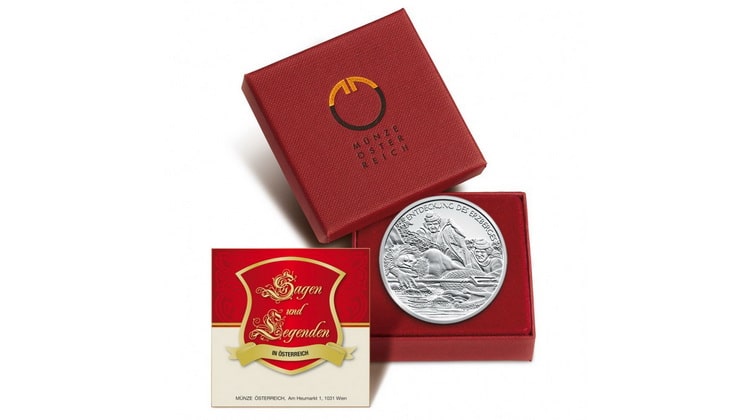
10 Austrian euro is a popular series of predominantly silver coins. It has been issued since 2002 when the national mint abolished the traditional shilling due to transition to a new currency. Coins are accepted for payment only on the territory of Austria, mostly taking place in private collections. The demand for silver 10 euros is quite high. The Austrian mint offers for sale relatively new coins of 2013-2018, whereas earlier copies of this face value can be purchased only from collectors.
A series of Austrian coins of 10 euro denomination
Between 2002 and 2018, several series of 10 euro coins were issued, dedicated to various historical characters and events that influenced the formation and development of both the Austrian state and the rest of Europe. Some attention was also paid to religious figures and traditional myths.
«Austria and her people»: castles
General specifications of the series
- Production: The Austrian Mint.
- Design: Herbert Weiner, Tomasz Pesendorfer, Andreas Zanaska.
- Metal: silver (Ag 925).
- Weight: 0.56 troy ounces(17.3 g).
- Diameter: 1.26 inches (32 mm).
- Edge: plain.
- Circulation: 130,000 (UNC), 20,000 (Special UNC), 50,000 (Frosted Proof).
- Date of issue: 4.24.2002.
- Obverse: view of Ambras Castle, built during the Renaissance; inscription «RepublikÖsterreich» at the top; year of minting and denomination at the bottom.
- Reverse: three musicians dancing in the Spanish hall; image is based on an engraving of 1569.
-
Date of issue: 9.10.2002.
-
Obverse: view of the Eggenberg Palace, built by Hans von Eggenberg. Four towers symbolize four seasons, 24 rooms represent the number of hours in a day, and 365 windows – the number of days in a year; inscription “Schloss Eggenberg” at the top; “RepublikÖsterreich” and face value at the bottom.
-
Reverse: image of the astronomer Johannes Kepler, who had a great influence on the owner of the palace; Kepler’s model of the “The Cosmographic Mystery ” (Latin Mysterium Cosmographicum) on the foreground; inscription “Johannes Kepler” to the left.
- Basilisk in Vienna, issued on April 15, 2009. The famous Schonlatern lane is on the obverse. On the left side, there is a facade of a house on which there is a famous fresco with a mirror and a student. On the reverse, there is a basilisk looking at his own reflection in the mirror, which is held by the student.
- Richard the Lionheart, issued on October 7, 2009. There is an image of Blondel on horseback at the castle of Dürnstein, singing a song composed by Richard the Lionheart. The captured king with the image of three lions on his chest is on the reverse.
- Erzberg in Styria, issued on April 14, 2010. There are images of two miners extracting ore in the Erzbergdeposit. The stylized mountain of the same name is on the background. There is a sleeping merman on the bank of the lake. Two men are crouching to him.
- Charlemagne in Untersberg, issued on October 13, 2010. There are shepherd boy and a gnome pointing to Untersberg Mountain. A flock of sheep is to the right. There are crows flying around the slopes of the famous mountain. There is an image of the shepherd and gnome entering the hall under the mountain and see the emperor sleeping on the throne on the reverse. A soldier leaning on a spear stands next to the emperor.
- Lindwurm in Klagenfurt, issued on May 4, 2011. There is a statue of the legendary dragon on the obverse. There is a fountain next to it. The castle, which purpose is to protect the city from the dragon is on the reverse. Captivated Lindwurm is near it.
- Oh, my darling Augustine, issued on October 12, 2011. There is an image of the musician Augustine, who survived the Viennese plague of 1678-1679 on the obverse. Augustine plays music in one of the taverns of Vienna on the reverse.
-
“Federal states of Austria” series
General specifications of the series
Production: The Austrian Mint.
Design: Tomasz Pesendorfer, Victoria Reicht.
Metal: silver (Ag 925), copper
Weight: 0.56troy ounces (17.3 g).
Diameter: 1.26 inches (32 mm).
Edge: plain.
Circulation:130,000 (Proof).
-
- Styria, issued on April 25, 2012. The first out of ten silver coins of the series. The “Green Mark”, depicted on the reverse, is not just a popular place of rest due to a large number of forests. The area, located near the ancient city of Graz, is famous throughout Europe for its fruit gardens and vineyards. The obverse depicts the world famous buildings of the capital of Styria.
- Carinthia, issued on September 26, 2012. The obverse depicts the falconry in the background of the castle Landskron. Since 2010, falconry officially has been an intangible heritage of UNESCO. The reverse depicts the 10-year-old Philip Ogris who described the spaces of Carinthia as follows: “Horses are jumping on the slopes of the Grossglockner, the boat is sailing along Wörthersee, the dragon is showing the tongue and laughing at the famous Carinthian sun, the clouds-sheep are watching from the sky.”
- Lower Austria, issued on May 15, 2013. On the obverse, there are miniature buildings of Melk Abbey, the gate of ancient Krems, the baroque church of Durnstein and, of course, the Danube with the famous wheeled steamship. There is the drawing of Christian Kopf from Ertl on the reverse. Christian depicted four geographical regions of Lower Austria, with Waldviertel and Weinfirtel, cider and industrial regions. He managed to take into account their main features. The engravers of the Austrian mint turned Christian’s drawing into a first-class coin design.
- Vorarlberg, issued on October 16, 2013. The coin’s obverse is dedicated to a unique weaving technique called “radhauba”. An improvised kokoshnik on the head of a woman on the foreground is made with this technique. It was kept in secret for centuries. Even today only a few artisans know it. In addition to this, there is a ship on Lake Constance on the background. There is a drawing by Alissa De Mori depicting the sights of the city of Bregenz, Lake Constance with boats, Pfänderbank and green meadows with grazing cows and a tractor on the reverse.
- Salzburg, issued on May 7, 2014. On the obverse, there is the historic center of the city, which is a UNESCO World Heritage Site. There is a drawing of Melisa Begich on the reverse, who managed to describe Salzburg in two images – Mozart and his music. Perhaps, the special atmosphere of this place really influenced the composer’s progress.
- Tyrol, issued on October 8, 2014. The obverse of the coin depicts the Tyrol during its famous carnival parade – Telfer Schleicherlaufen, which takes place in Telfs every five years. The reverse is a collection of both ancient and newest Tyrol places of interest on the reverse.
- Vienna, issued on June 10, 2015. a collage of historically important buildings in Vienna on the obverse. You can see Karlskirche (at the bottom left) near St. Stephen’s Cathedral, the Vienna City Hall, the Belvedere Palace, the Secession building and the Vienna State Opera. There is a carriage of fiacres and a statue of Johann Strauss in the city park to the right on the foreground. There is a child’s drawing depicting St. Stephen’s Cathedral on the reverse.
- Burgenland, issued on October 7, 2015. The obverse of the coin depicts two herons searching for prey in the lake. The bigger one has a frog in its beak. There are hills, vineyards, and a mooring also. The towers of the Evangelical and Fishermen’s Church of the city of Rust on Neusiedlerese are on the left. There is a drawing by Leonie Schrollenberger on the reverse: wine, an idyllic village, the Esterházy Palace, Lake Neusiedl, a stork.
- Upper Austria, issued on June 01, 2016. On the obverse, there is a landscape of Hallstatt with the mountains on the background. There is a church on the hill of Posilinberg on the reverse of the coin.
- Austria, issued on October 5, 2016. The obverse depicts a collage with five motifs that represent Austria: Grossglockner, Emperor Franz Joseph I, young Mozart on piano, the theme “Mother and Child” from the painting “Three Centuries of a Woman” by Gustav Klimt (1905) and a skier. On the other side of the coin, you can see the adapted design of the winner of the competition. The image represents ten children holding hands. Children surround the contour of the country with a heart in the middle.
- St. Michael, issued on February 22, 2017. Front side – the image of a sword with a wavy blade, placed between the scales. The sword and the scales are symbols of Michael. The letter “M” dominates over all symbols, framed by rich leaf ornament. On the other side. there is an image of St. Michael of the end of the 13th century named “St. Michael fights the dragon “, and a detail of the medieval altar in the church of San Michele de Soriguerola.
- Archangel Gabriel, issued on September 6, 2017. The obverse depicts the Gabriel symbol – a lily, framed by the letter “G” and leaf ornament. There is a portrait of Gabriel, a fragmentary reproduction of the picture, which was written in the 15th or 16th century. It is assumed that the artist was a representative of the German school.
- Archangel Raphael, issued on February 14, 2018. There is an image of the archangel Raphael – a young man with wavy hair and a pilgrim’s stick, and wings made of peacock feathers on the reverse. Raphael is the patron of pilgrims and travelers, he is revered by both Christians and Jews as an angel with special healing powers. The obverse of the coin is decorated traditionally for the series: fish as a symbol of the archangel is framed by the letter “R”.
- The exclusive series “Federal Lands of Austria” differs from other due to interesting innovations. The image on the reverse of each coin was skillfully copied from the drawings of the winners of a special children’s competition titled “Austria by the hands of children”. Handwork and the most modern technologies made each piece of silver a unique work of art. On the other side of the coins of the series, you can find cultural values that are part of UNESCO’s world heritage.
- The Austrian Mint is one of the oldest in Europe. Its equipment allows producing items of the highest quality using all known embossing methods. Engravers continue to develop unusual works of art, for them, gold and silver Euros of Austria is not just work, but a real passion.
- Coins of the series “Celestial Patrons” are made of silver and copper. Moreover, there is a limited edition of exclusive silver coins with colored embossing. They are made in colors that symbolize heavenly patrons. This is an excellent talisman for all occasions.
- The very first euro coin was invented in Austria on November 20, 1998, by the Austrian Finance Minister of that time Rudolf Edlinger.

“Heavenly patrons” series
General specifications of the series
Production: The Austrian Mint.
Design: Helmut Andeckinger, Herbert Weiner.
Metal: silver (Ag 925), copper
Weight: 0.50troy ounces (16.8 g).
Diameter: 1.26 inches (32 mm).
Edge: plain.
Circulation: 130,000 (Proof)

The cost of the coins
The price of these coins is relatively low today, as the euro is a relatively young currency. The cost varies depending on the country and the condition of the coin but usually ranges from 1,250 to 2,800 rubles per coin in the original packaging. Collectible coins – a reasonable investment of funds, and over the years all of the series described above will definitely rise in price.
Interesting facts
Ambras Castle
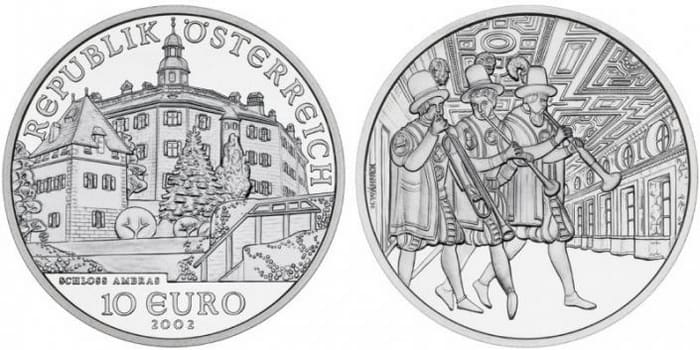
Eggenberg Palace
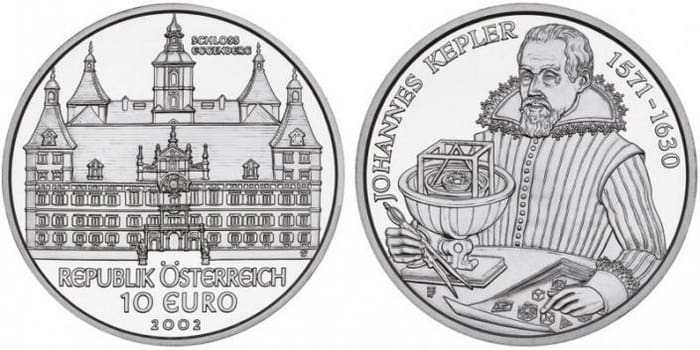
Schloss Hof Castle
Date of issue: 4.9.2003.
Obverse: view of Schloss Hof Castle from the garden side with terraces; inscription “Republik Österreich” at the top; denomination and year of minting the bottom.
Reverse: two gardeners dressed in the Baroque style.

Schönbrunn Palace
Date of issue: 10.8.2003.
Obverse: facade of the palace (central part); large fountain on the foreground; inscription “Schloss Schönbrunn” at the top; “Republik Österreich” and face value at the bottom.
Reverse: palace garden behind the glass (Palmenhaus), built in the 19th century (the garden was a museum of rare and exotic plants; the largest building of glass and steel in Europe at that time)
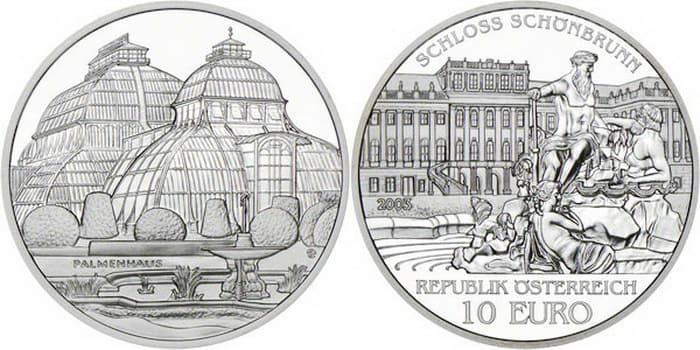
Hellbrunn Palace
Date of issue: 4.21.2004.
Obverse: central facade of the castle on the foreground; mountain massif in Salzburg on the background; an inscription “Republik Österreich” at the top; “Schloss Hellbrunn” and face value at the bottom.
Reverse: Archbishop Markus von Hohenems, making the plan for buildinging the Salzburg Cathedral; “Roman theater” from Hellbrunn on the background; inscription “Bishop Markus von Hohenems 1612-1619 (Erzhbishop Markus Sitticus von Hohenems)”
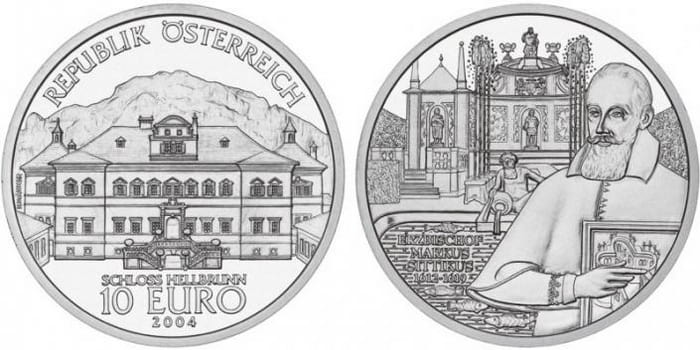
Artstetten Castle
Date of issue: 10.13.2004.
Obverse: Artstetten Castle in Wachau, built in the 13th century; inscription “Republik Österreich” at the top; “Schloss Artstetten” below it; face value and year of minting at the bottom
Reverse: gate to the family crypt of the Hohenbergs; two portraits to the left – the Duchess of Hohenberg and her husband, Archduke Franz Ferdinand; inscription «Erzherzog Franz Ferdinand, Erzherzogin Sophie von Hohenberg» at the top.

“60 years of the Second Republic” series
General specifications of the series
Production: The Austrian Mint.
Design: Herbert Weiner, Helmut Andeckinger.
Metal: silver (Ag 925).
Weight: 0.56 troy ounces (17.3 g).
Diameter: 1.26 inches (32 mm).
Edge: plain.
Circulation: 13,000 (Circulation), 40,000 (UNC), 60,000 (Frosted Proof).
60 years of the Second Republic
Date of issue: 5.11.2005.
Obverse: Athena, the goddess of wisdom of ancient Greece standing in front of the building of the Austrian Parliament (Athena-Pallada is a symbol of the country); coats of arms of the federal states of Austria around her; inscription «Republik Österreich» at the top; face value to the left; year of minting to the right.
Reverse: building of the Austrian parliament with a torn chain; happy citizens alongside; broken chain symbolizes the liberation of the country (it is also present on the claws of the national eagle) inscription «60 Jahre Zweite Republik» at the bottom.
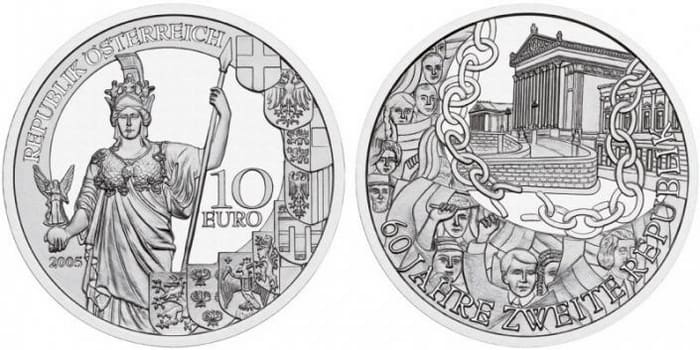
The opening of the Burgtheater and the Vienna State Opera in 1955
Date of issue: 10.12.2005.
Obverse: building of the Opera theater; National Opera behind it; inscription “Republik Österreich” and face value at the bottom.
Reverse: symbols of the theater – masks of tragedy and comedy; inscription «Wiedereröffnung von und Burg Oper 1955» along the rim.
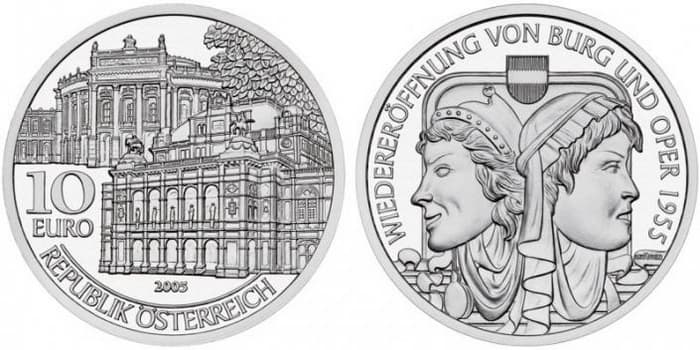
Series “Austria and her people”: the famous abbeys
General specifications of the series
Production: The Austrian Mint.
Design: Herbert Weiner, Tomasz Pesendorfer.
Metal: silver (Ag 925).
Weight: 0.56 troy ounces (17.3 g).
Diameter: 1.26 inches (32 mm).
Edge: plain.
Circulation: 130,000 (UNC), 40,000 (Special UNC), 60,000 (Frosted Proof).
Nonnberg Abbey
Date of issue: 10.12.2005.
Obverse: Nönberg monastery of the Benedictines; church of Kajetanerom the background; inscription “Benediktinerinnenabtei Nonnberg” at the top; inscription “RepublikÖsterreich” and denomination.
Reverse: Crypt of St. Erentrudis, the first abbess of the monastery; inscription «Erentrudis».
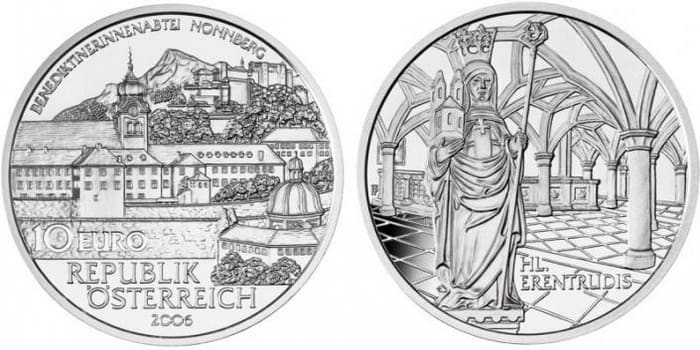
Göttweig Abbey
Date of issue: 10.11.2006.
Obverse: monastery with towers surrounded by vineyards; inscription “Benediktinerstift Göttweig” at the top; inscription “Republik Österreich” and face value.
Reverse: staircases leading to the chambers in the main building of the abbey; portrait of Charles VI on the foreground, for whom rooms of the monastery were originally prepared; inscription «Kaiserstiege Carolus».
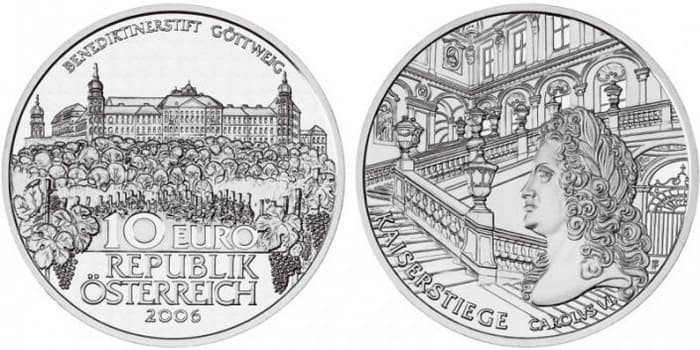
Melk Abbey
Date of issue: 18.04.2007.
Obverse: double tower and church dome; facade of the abbey church; shrines of the monastery, including the cross of St. Peter; inscriptions “Stift Melk” and “Republik Österreich”; face value.
Reverse: main dome of the church with a painting of the sky by Johann Michael Rottmayr; inscription «Das Kreuz Melker».
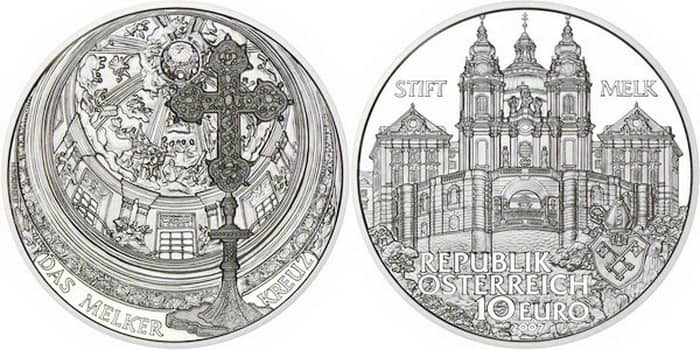
Saint Paul’s Abbey in Lavanttal
Date of issue: 10.10.2007.
Obverse: view of the abbey on the hill; inscription «St. Paul imLavantal» at the top.
Reverse: southern portal of the cathedral built in 1618.
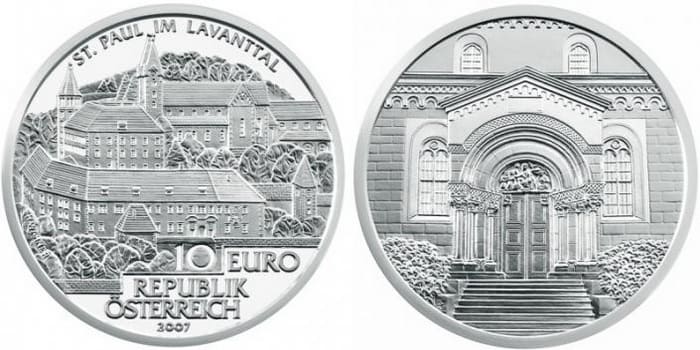
Klosterneuburg Abbey
Date of issue:04.16.2008.
Obverse: view of the abbey from the hill in the Alps; inscription “Stift Klosterneuburg” at the top; inscription “Republik Österreich” and face value at the bottom.
Reverse: cloister of the monastery; stained glass of Margrave Leopold III on the foreground.
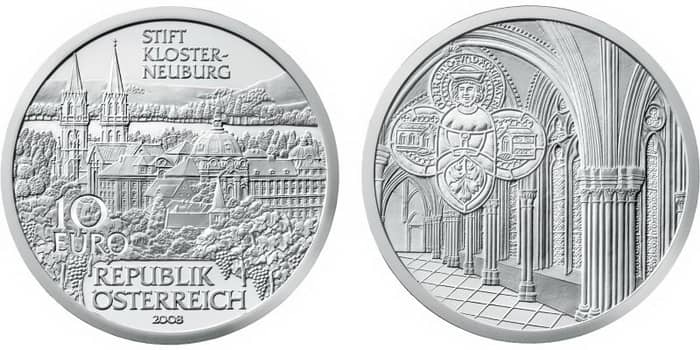
Seckau Abbey
Date of issue: 10.8.2008.
Obverse: view of the monastery, basilica, and other buildings in the Baroque style; the inscription “Benediktinerabtei Seckau” at the top; “Republik Österreich” and face value at the bottom.
Reverse: view of the altar from the main entrance of the cathedral.
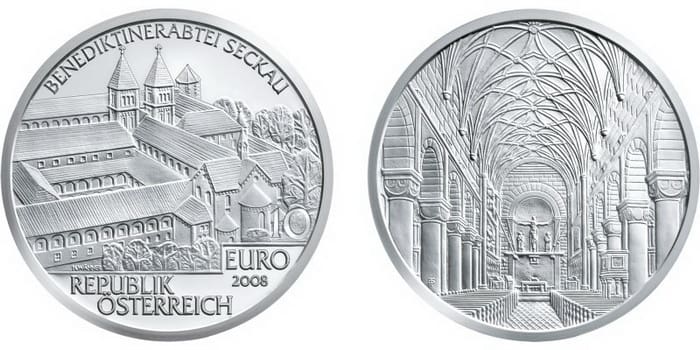
Series “Myths and legends of Austria”
General specifications of the series
Production: The Austrian Mint.
Design: Herbert Weiner, Tomasz Pesendorfer.
Metal: silver (Ag 925).
Weight: 0.51 troy ounces (16 g).
Diameter: 1.26 inches (32 mm).
Edge: plain.
Circulation: 130,000 (UNC), 30,000 (Special UNC), 40,000 (Proof).
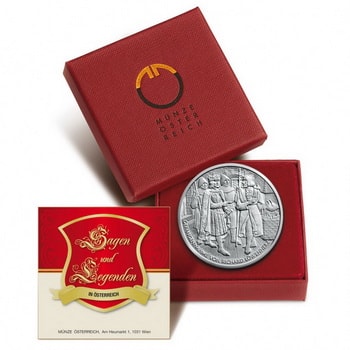
Comments
No commens yet.